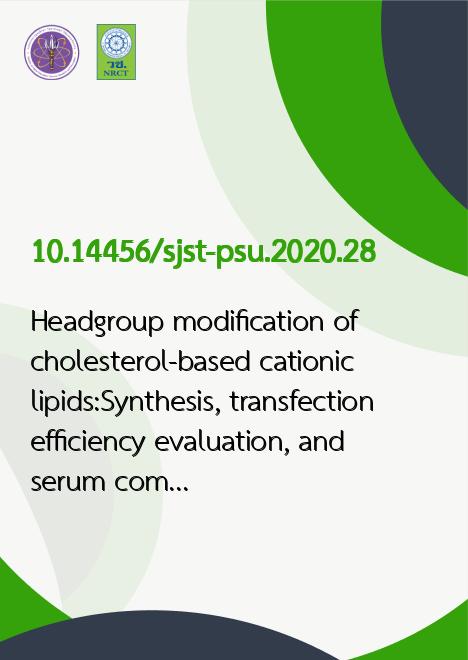
|
Headgroup modification of cholesterol-based cationic lipids:Synthesis, transfection efficiency evaluation, and serum compatibility |
|---|---|
| รหัสดีโอไอ | |
| Creator | 1. Chopaka Thongbamrer 2. Nattisa Niyomtham 3. Chayutra Chaiwut 4. Charoen Posa 5. Nuttapon Apiratikul 6. Ek Sangvichien 7. Praneet Opanasopit 8. Uthai Sakee 9. Boon-ek Yingyongnarongkul 10. Widchaya Radchatawedchakoon |
| Title | Headgroup modification of cholesterol-based cationic lipids:Synthesis, transfection efficiency evaluation, and serum compatibility |
| Publisher | Research and Development Office, Prince of Songkla University |
| Publication Year | 2563 |
| Journal Title | Songklanakarin Journal of Science and Technology |
| Journal Vol. | 42 |
| Journal No. | 1 |
| Page no. | 213-221 |
| Keyword | cationic lipid, cholesterol, serum compatibility, tetramethylguanidinium headgroup, transfection |
| URL Website | https://rdo.psu.ac.th/sjstweb/index.php |
| ISSN | 0125-3395 |
| Abstract | There were two objectives for this study. First, it focused on eight lipids having cholesterol as hydrophobic tails,carbamate linkers, and different polar headgroups. Second, it aimed to study the physicochemical properties of those eight lipids,including DNA binding, size, zeta potential, and the transfection efficiency. Cholesterol-1,2-diaminoethane andtetramethylguanidinium conjugated lipid showed the highest transfection efficacy into human embryonic kidney cells cells. Theoptimal formulation of this lipid was found to be 1:1 (weight/weight) for cationic lipid/DOPE, and 1:20 for DNA/liposome. GFPexpression experiments further revealed that the liposome exhibited higher transfection efficiency under a 10?40% serumcondition than LipofectamineTM 2000. |
